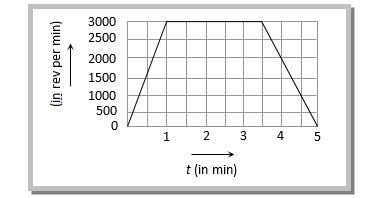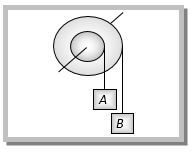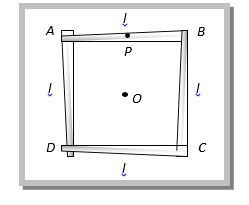11th And 12th > Physics
ROTATION THE BASIC DEFINITION MCQs
Total Questions : 30
| Page 1 of 3 pages
Answer: Option D. ->
11250
:
D
Number of revolution = Area between the graph and time axis = Area of trapezium
=12×(2.5+5)×3000=11250 revolution.
:
D
Number of revolution = Area between the graph and time axis = Area of trapezium
=12×(2.5+5)×3000=11250 revolution.
Answer: Option C. ->
y = 2x
:
C
Linear displacement (S) = Radius (r) × Angular displacement (θ)
∴S∝r(if θ=constant)
Distance travelled by mass A(x)Distance travelled by mass A(y)=Radius of pulley concerned with mass A(r)Radius of pulley concerned with mass A(2r)=12⇒y=2x.
:
C
Linear displacement (S) = Radius (r) × Angular displacement (θ)
∴S∝r(if θ=constant)
Distance travelled by mass A(x)Distance travelled by mass A(y)=Radius of pulley concerned with mass A(r)Radius of pulley concerned with mass A(2r)=12⇒y=2x.
Answer: Option A. ->
(8ˆi−6ˆj+3ˆk)
:
A
⃗v=⃗ω×⃗r=(3ˆi+4ˆj+0ˆk)×(0ˆi+ˆj+2ˆk)=∣∣
∣
∣∣ˆiˆjˆk340012∣∣
∣
∣∣=8ˆi−6ˆj+3ˆk
:
A
⃗v=⃗ω×⃗r=(3ˆi+4ˆj+0ˆk)×(0ˆi+ˆj+2ˆk)=∣∣
∣
∣∣ˆiˆjˆk340012∣∣
∣
∣∣=8ˆi−6ˆj+3ˆk
Answer: Option A. ->
Iy=64Ix
:
A
Moment of Inertia of disc I=12MR2=12(πR2tρ)R2=12πtρR4
[As M=V×ρ=πR2tρ where t = thickness, ρ = density]
∴IyIx=tytx(RyRx)4 [ If ρ = constant]
⇒IyIx=14(4)4=64 [Given Ry=4Rx,ty=tx4]
⇒Iy=64Ix
:
A
Moment of Inertia of disc I=12MR2=12(πR2tρ)R2=12πtρR4
[As M=V×ρ=πR2tρ where t = thickness, ρ = density]
∴IyIx=tytx(RyRx)4 [ If ρ = constant]
⇒IyIx=14(4)4=64 [Given Ry=4Rx,ty=tx4]
⇒Iy=64Ix
Answer: Option B. ->
0.1kgm2
:
B
We will not consider the moment of inertia of ring because it doesn't have any mass. So, moment of inertia of five particle system I=5mr2=5×2×(0.1)2=0.1kg−m2.
Note: The masses are concentrated at fixed distance from the axis similar to that of ring. That is why you simply need to add all the individual contributions.
:
B
We will not consider the moment of inertia of ring because it doesn't have any mass. So, moment of inertia of five particle system I=5mr2=5×2×(0.1)2=0.1kg−m2.
Note: The masses are concentrated at fixed distance from the axis similar to that of ring. That is why you simply need to add all the individual contributions.
Answer: Option B. ->
6 l
:
B
Moment of inertia of disc about a diameter =14MR2=I(given) ∴MR2=4I
Now moment of inertia of disc about an axis perpendicular to its plane and passing through a point on its rim
=32MR2=32(4I)=6I.
:
B
Moment of inertia of disc about a diameter =14MR2=I(given) ∴MR2=4I
Now moment of inertia of disc about an axis perpendicular to its plane and passing through a point on its rim
=32MR2=32(4I)=6I.
Answer: Option A. ->
43Ml2.
:
A
Moment of inertia of rod AB about point P=112Ml2
M.I. of rod AB about point O=Ml212+M(12)2=13Ml2 [by the theorem of parallel axis]
and the system consists of 4 rods of similar type so by the symmetry ISystem=43Ml2.
:
A
Moment of inertia of rod AB about point P=112Ml2
M.I. of rod AB about point O=Ml212+M(12)2=13Ml2 [by the theorem of parallel axis]
and the system consists of 4 rods of similar type so by the symmetry ISystem=43Ml2.
Answer: Option D. ->
72MR2
:
D
M.I of system about YY' I=I1+I2+I3
here I1 = moment of inertia of ring about diameter, I2=I3=M.I. of inertia of ring about a tangent in a plane
∴ I=12mR2+32mR2+32mR2=72mR2
:
D
M.I of system about YY' I=I1+I2+I3
here I1 = moment of inertia of ring about diameter, I2=I3=M.I. of inertia of ring about a tangent in a plane
∴ I=12mR2+32mR2+32mR2=72mR2
Answer: Option C. ->
IA<IB
:
C
Moment of inertia of circular disc about an axis passing through centre and normal to the circular face
I=12MR2=12M(Mπtρ) [As M=Vρ=πR2tρ ∴R2=Mπtρ]
⇒I=M22πtρ or I∝1ρ If mass and thickness are constant.
So, in the problem IAIB=dBdA ∴IA<IB [AsdA>dB]
:
C
Moment of inertia of circular disc about an axis passing through centre and normal to the circular face
I=12MR2=12M(Mπtρ) [As M=Vρ=πR2tρ ∴R2=Mπtρ]
⇒I=M22πtρ or I∝1ρ If mass and thickness are constant.
So, in the problem IAIB=dBdA ∴IA<IB [AsdA>dB]
Answer: Option B. ->
24.4 N-m
:
B
⃗F=(2ˆi−4ˆj+2ˆk)N and ⃗r=(3i+2−4ˆk) meter
Torque ⃗τ=⃗r×⃗F=∣∣
∣
∣∣ˆiˆjˆk32−42−42∣∣
∣
∣∣⇒⃗τ=−12ˆi−14ˆj−16ˆj−16ˆkand|⃗τ|=√(−12)2+(−14)2+(−16)2=
24.4 N-m
:
B
⃗F=(2ˆi−4ˆj+2ˆk)N and ⃗r=(3i+2−4ˆk) meter
Torque ⃗τ=⃗r×⃗F=∣∣
∣
∣∣ˆiˆjˆk32−42−42∣∣
∣
∣∣⇒⃗τ=−12ˆi−14ˆj−16ˆj−16ˆkand|⃗τ|=√(−12)2+(−14)2+(−16)2=
24.4 N-m



















